
Wolf 359 is a red dwarf star located in the constellation Leo, near the ecliptic. At a distance of 7.86 light-years from Earth, it has an apparent magnitude of 13.54 and can only be seen with a large telescope. Wolf 359 is one of the nearest stars to the Sun with only the Alpha Centauri system, Barnard's Star, and the brown dwarfs Luhman 16 and WISE 0855−0714 known to be closer. Its proximity to Earth has led to its mention in several works of fiction.
Ross 154 is a star in the southern zodiac constellation of Sagittarius. It has an apparent visual magnitude of 10.44, making it much too faint to be seen with the naked eye. At a minimum, viewing Ross 154 requires a telescope with an aperture of 6.5 cm (3 in) under ideal conditions. The distance to this star can be estimated from parallax measurements, which places it at 9.71 light-years away from Earth. It is the nearest star in the southern constellation Sagittarius, and one of the nearest stars to the Sun.
Ross 248, also called HH Andromedae or Gliese 905, is a small star approximately 10.30 light-years from Earth in the northern constellation of Andromeda. Despite its proximity it is too dim to be seen with the naked eye. It was first catalogued by Frank Elmore Ross in 1926 with his second list of proper-motion stars; on which count it ranks 261st in the SIMBAD database. It was too dim to be included in the Hipparcos survey. In about 40,000 years, Voyager 2 will pass 1.7 light-years from the star.

Ross 128 is a red dwarf star in the equatorial zodiac constellation of Virgo, near β Virginis. The apparent magnitude of Ross 128 is 11.13, which is too faint to be seen with the unaided eye. Based upon parallax measurements, the distance of this star from Earth is 11.007 light-years, making it the twelfth closest stellar system to the Solar System. It was first cataloged in 1926 by American astronomer Frank Elmore Ross.
HD 46375 is double star with an exoplanetary companion in the equatorial constellation of Monoceros. It presents as an 8th-magnitude star with an apparent visual magnitude of 7.91, which is too dim to be readily visible to the naked eye. The system is located at a distance of 96.5 light-years from the Sun based on parallax measurements, but is slowly drifting closer with a radial velocity of −1 km/s. The common proper motion stellar companion, designated HD 46375 B, has a linear projected separation of 346±13 AU.

A flare star is a variable star that can undergo unpredictable dramatic increases in brightness for a few minutes. It is believed that the flares on flare stars are analogous to solar flares in that they are due to the magnetic energy stored in the stars' atmospheres. The brightness increase is across the spectrum, from X-rays to radio waves. Flare activity among late-type stars was first reported by A. van Maanen in 1945, for WX Ursae Majoris and YZ Canis Minoris. However, the best-known flare star is UV Ceti, first observed to flare in 1948. Today similar flare stars are classified as UV Ceti type variable stars in variable star catalogs such as the General Catalogue of Variable Stars.
Struve 2398 is a binary star system in the northern constellation of Draco. Struve 2398 is star number 2398 in the Struve Double Star Catalog of Russian-German astronomer Friedrich Georg Wilhelm von Struve. The astronomer's surname, and hence the star identifier, is sometimes indicated by a Greek sigma, Σ; hence, this system can be listed with the identifier Σ 2398. Although the components are too faint to be viewed with the naked eye, this star system is among the closest to the Sun. Parallax measurements by the Gaia spacecraft give them an estimated distance of 11.5 light-years away.
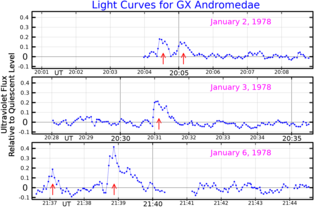
Groombridge 34 is a binary star system in the northern constellation of Andromeda. It was listed as entry number 34 in A Catalogue of Circumpolar Stars, published posthumously in 1838 by British astronomer Stephen Groombridge. Based upon parallax measurements taken by the Gaia spacecraft, the system is located about 11.6 light-years from the Sun. This positions the pair among the nearest stars to the Solar System.
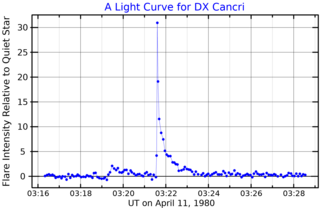
DX Cancri is a variable star in the northern zodiac constellation of Cancer. With an apparent visual magnitude of 14.81, it is much too faint to be seen with the naked eye. Visually viewing this star requires a telescope with a minimum aperture of 16 in (41 cm). Based upon parallax measurements, DX Cancri is located at a distance of 11.8 light-years from Earth. This makes it the 18th closest star to the Sun.
Gliese 674(GJ 674) is a small red dwarf star with an exoplanetary companion in the southern constellation of Ara. It is too faint to be visible to the naked eye, having an apparent visual magnitude of 9.38 and an absolute magnitude of 11.09. The system is located at a distance of 14.85 light-years from the Sun based on parallax measurements, but is drifting closer with a radial velocity of −2.9 km/s. It is a candidate member of the 200 million year old Castor stream of co-moving stars.
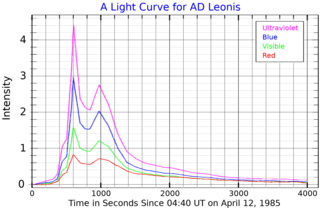
AD Leonis (Gliese 388) is a red dwarf star. It is located relatively near the Sun, at a distance of 16.2 light-years, in the constellation Leo. AD Leonis is a main sequence star with a spectral classification of M3.5V. It is a flare star that undergoes random increases in luminosity.

AB Doradus is a pre-main-sequence quadruple star system in the constellation Dorado. The primary is a flare star that shows periodic increases in activity.
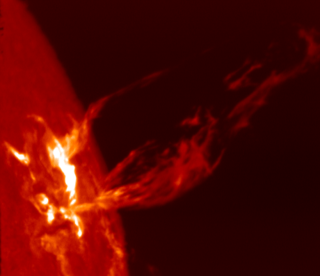
A stellar magnetic field is a magnetic field generated by the motion of conductive plasma inside a star. This motion is created through convection, which is a form of energy transport involving the physical movement of material. A localized magnetic field exerts a force on the plasma, effectively increasing the pressure without a comparable gain in density. As a result, the magnetized region rises relative to the remainder of the plasma, until it reaches the star's photosphere. This creates starspots on the surface, and the related phenomenon of coronal loops.
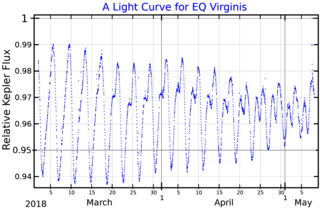
EQ Virginis is a single variable star in the equatorial constellation of Virgo. It has a baseline visual apparent magnitude of 9.36, but is a flare star that undergoes sporadic bursts of brightening. The star is located at a distance of 67 light-years from the Sun based on parallax measurements, but is drifting closer with a radial velocity of −23 km/s. It is a member of the IC 2391 moving group of stars, which is between 30 and 50 million years old.
GJ 3379 is the nearest star in the Orion constellation, located at a distance of 17 light years from the Sun based on parallax. It is a single star with an apparent visual magnitude of +11.31 and an absolute magnitude of +12.71, therefore, the star is not visible with the naked eye. It is positioned in the upper left part of the Orion constellation, to the SSE of Betelgeuse. This star is drifting further away with a radial velocity of +30.0 kilometers per second. In the past, this star had a relatively close encounter with the Solar System. Some 161,000±6,000 years ago, it achieved a minimum distance of 4.08 ± 0.20 ly (1.25 ± 0.06 pc).
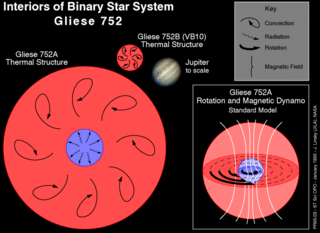
Gliese 752 is a binary star system in the Aquila constellation. This system is relatively nearby, at a distance of 19.3 light-years.
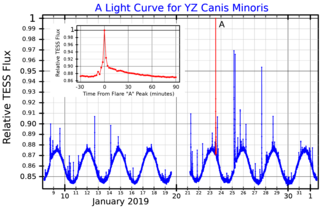
YZ Canis Minoris is a red-hued star in the equatorial constellation of Canis Minor. With an apparent visual magnitude of 11.15, it is much too faint to be viewed with the naked eye. The distance to YZ CMi can be estimated from its annual parallax shift of 167 mas, yielding a value of 19.5 light years. Presently the star is moving further away with a heliocentric radial velocity of +26.5 km/s. It made its closest approach some 162,000 years ago when it made perihelion passage at a distance of 10.2 ly. YZ CMi is a potential member of the Beta Pictoris moving group.

Gliese 163 is a faint red dwarf star with multiple exoplanetary companions in the southern constellation of Dorado. Other stellar catalog names for it include HIP 19394 and LHS 188. It is too faint to be visible to the naked eye, having an apparent visual magnitude of 11.79 and an absolute magnitude of 10.91. This system is located at a distance of 49.4 light-years from the Sun based on parallax measurements. Judging by its space velocity components, it is most likely a thick disk star.
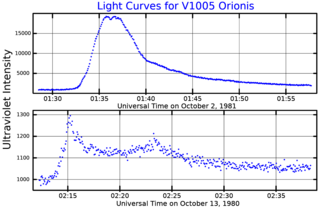
V1005 Orionis is a young flare star in the equatorial constellation of Orion. It has the identifier GJ 182 in the Gliese–Jahreiß catalogue; V1005 Ori is its variable star designation. This star is too faint to be visible to the naked eye, having a mean apparent visual magnitude of 10.1. It is located at a distance of 79.6 light years from the Sun and is drifting further away with a radial velocity of 19.2 km/s. The star is a possible member of the IC 2391 supercluster.
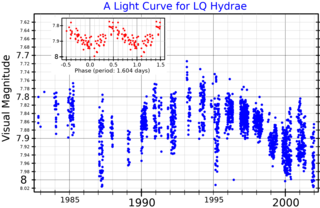
LQ Hydrae is a single variable star in the equatorial constellation of Hydra. It is sometimes identified as Gl 355 from the Gliese Catalogue; LQ Hydrae is the variable star designation, which is abbreviated LQ Hya. The brightness of the star ranges from an apparent visual magnitude of 7.79 down to 7.86, which is too faint to be readily visible to the naked eye. Based on parallax measurements, this star is located at a distance of 59.6 light years from the Sun. It is drifting further away with a radial velocity of 7.6 km/s.
















